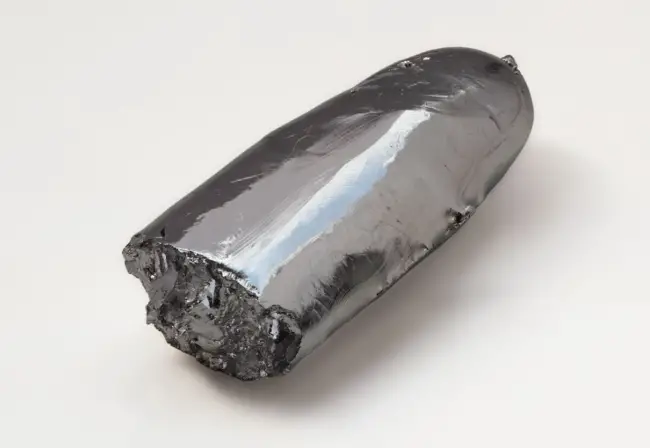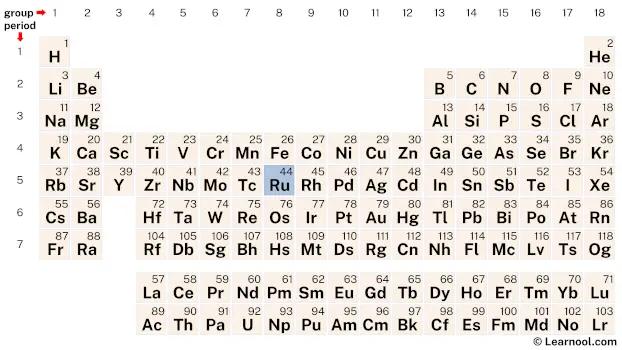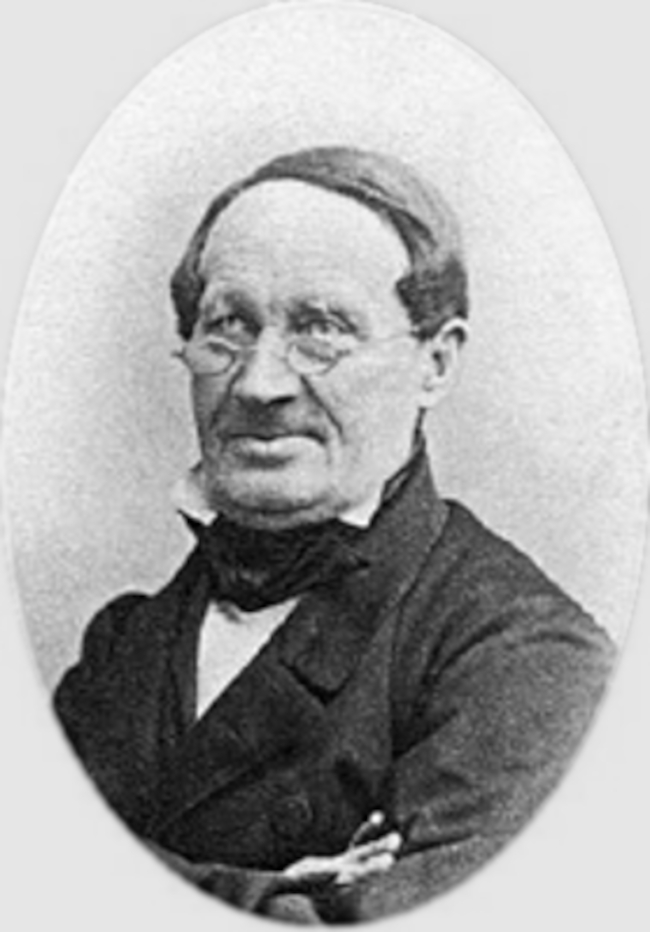
Ruthenium (Ru) is a chemical element of the periodic table, located in the group 8 and the period 5, and has the atomic number 44. It is a hard, brittle, rare, lustrous, silvery-white transition metal, which is named after Ruthenia, the Latin name for Russia.
On periodic table
| group | ⇨ | 1 | 2 | 3 | 4 | 5 | 6 | 7 | 8 | 9 | 10 | 11 | 12 | 13 | 14 | 15 | 16 | 17 | 18 |
| period | ⇩ | ||||||||||||||||||
| 1 | 1 H  Hydrogen |
2 He  Helium |
|||||||||||||||||
| 2 | 3 Li  Lithium |
4 Be  Beryllium |
5 B  Boron |
6 C  Carbon |
7 N  Nitrogen |
8 O  Oxygen |
9 F  Fluorine |
10 Ne  Neon |
|||||||||||
| 3 | 11 Na  Sodium |
12 Mg  Magnesium |
13 Al  Aluminium |
14 Si Silicon |
15 P  Phosphorus |
16 S  Sulfur |
17 Cl  Chlorine |
18 Ar  Argon |
|||||||||||
| 4 | 19 K  Potassium |
20 Ca  Calcium |
21 Sc  Scandium |
22 Ti  Titanium |
23 V  Vanadium |
24 Cr  Chromium |
25 Mn  Manganese |
26 Fe  Iron |
27 Co  Cobalt |
28 Ni  Nickel |
29 Cu  Copper |
30 Zn  Zinc |
31 Ga  Gallium |
32 Ge  Germanium |
33 As  Arsenic |
34 Se  Selenium |
35 Br  Bromine |
36 Kr  Krypton |
|
| 5 | 37 Rb  Rubidium |
38 Sr  Strontium |
39 Y  Yttrium |
40 Zr  Zirconium |
41 Nb  Niobium |
42 Mo  Molybdenum |
43 Tc  Technetium |
44 Ru Ruthenium |
45 Rh  Rhodium |
46 Pd  Palladium |
47 Ag  Silver |
48 Cd  Cadmium |
49 In  Indium |
50 Sn  Tin |
51 Sb  Antimony |
52 Te  Tellurium |
53 I  Iodine |
54 Xe  Xenon |
|
| 6 | 55 Cs  Caesium |
56 Ba  Barium |
72 Hf  Hafnium |
73 Ta  Tantalum |
74 W  Tungsten |
75 Re  Rhenium |
76 Os  Osmium |
77 Ir  Iridium |
78 Pt  Platinum |
79 Au  Gold |
80 Hg  Mercury |
81 Tl  Thallium |
82 Pb  Lead |
83 Bi  Bismuth |
84 Po  Polonium |
85 At  Astatine |
86 Rn  Radon |
||
| 7 | 87 Fr  Francium |
88 Ra  Radium |
104 Rf  Rutherfordium |
105 Db  Dubnium |
106 Sg  Seaborgium |
107 Bh  Bohrium |
108 Hs  Hassium |
109 Mt  Meitnerium |
110 Ds  Darmstadtium |
111 Rg  Roentgenium |
112 Cn  Copernicium |
113 Nh  Nihonium |
114 Fl  Flerovium |
115 Mc  Moscovium |
116 Lv  Livermorium |
117 Ts  Tennessine |
118 Og  Oganesson |
||
| 57 La  Lanthanum |
58 Ce  Cerium |
59 Pr  Praseodymium |
60 Nd  Neodymium |
61 Pm  Promethium |
62 Sm  Samarium |
63 Eu  Europium |
64 Gd  Gadolinium |
65 Tb  Terbium |
66 Dy  Dysprosium |
67 Ho  Holmium |
68 Er  Erbium |
69 Tm  Thulium |
70 Yb  Ytterbium |
71 Lu  Lutetium |
|||||
| 89 Ac  Actinium |
90 Th  Thorium |
91 Pa  Protactinium |
92 U  Uranium |
93 Np  Neptunium |
94 Pu  Plutonium |
95 Am  Americium |
96 Cm  Curium |
97 Bk  Berkelium |
98 Cf  Californium |
99 Es  Einsteinium |
100 Fm  Fermium |
101 Md  Mendelevium |
102 No  Nobelium |
103 Lr  Lawrencium |
|||||
| – d block |
Ruthenium is a d-block element, situated in the eighth column and the fifth row of the periodic table, denoted by the atomic number 44 and chemical symbol Ru.
Element information
 |
|
 |
|
| Origin of name | named after Ruthenia, the Latin name for Russia |
| Symbol | Ru |
| Atomic number (Z) | 44 |
| Atomic mass | 101.07 u |
| Block | d-block |
| Group | 8 |
| Period | 5 |
| Classification | Transition metal |
| Atomic radius | 134 pm |
| Covalent radius | 146±7 pm |
| Melting point | 2334 ℃, 4233 ℉, 2607 K |
| Boiling point | 4150 ℃, 7502 ℉, 4423 K |
| Electron configuration | [Kr] 4d7 5s1 |
| Electrons per shell | 2, 8, 18, 15, 1 |
| Crystal structure | Hexagonal close-packed (hcp) |
| Phase at r.t | Solid |
| Density near r.t | 12.45 g/cm3 |
| Main isotopes | Ruthenium-96, Ruthenium-98, Ruthenium-99, Ruthenium-100, Ruthenium-101, Ruthenium-102, Ruthenium-104 |
| Natural occurrence | Primordial |
| Oxidation state | +3, +4 |
| Electronegativity (Pauling scale) | 2.2 |
| Protons Neutrons Electrons |
44 57 44 |
| Learn how to find: Ruthenium protons neutrons electrons | |
| CAS number | 7440-18-8 |
| Discovered by | Karl Ernst Claus in 1844 |
History

Ruthenium was discovered by a Russian chemist named Karl Klaus in 1844. Klaus was studying platinum ores from the Ural Mountains when he discovered a small amount of a new element that he named “ruthenium” after Ruthenia, the Latin word for Russia. The discovery was later confirmed by another Russian chemist named Gottfried Osann.
However, it was not until 1860 that the element was isolated in pure form by the German chemist Karl Ernst Claus, who was able to obtain a few grams of the metal by reducing its oxide with hydrogen gas. Since then, ruthenium has been identified as a rare and valuable element with important applications in industry, electronics, and catalysis.
Occurrence and production
Ruthenium is a rare transition metal that occurs naturally in the Earth’s crust at very low concentrations, typically in ores containing platinum group metals. The largest deposits of ruthenium are found in the Ural Mountains of Russia, although it is also found in smaller quantities in North and South America, as well as in other parts of the world. The main sources of ruthenium are sulfide and platinum group metal ores, with production typically achieved as a by-product of refining these ores.
The production of ruthenium is a complex and multistage process that involves several steps, including mining, concentration, smelting, and refining. The first step involves the extraction of the ore from the ground, typically through underground or open-pit mining. The next step is concentration, in which the ore is processed to remove impurities and increase the concentration of ruthenium. This is typically achieved through froth flotation, a process in which the ore is mixed with water and chemicals that cause the desired minerals to float to the top.
The concentrated ore is then smelted to remove any remaining impurities and to separate the various metals contained within it. This process typically involves heating the ore in a furnace with a reducing agent, such as carbon, which reacts with the oxygen in the ore to form carbon dioxide and leave behind the desired metal. The resulting metal is then further refined through a process of chemical purification, typically involving the use of solvents or electrolysis, to produce high-purity ruthenium.
Properties
Ruthenium is a hard, silvery-white metal that belongs to the platinum group of elements.
It has a high melting point of 2334 ℃ and a boiling point of 4150 ℃.
Ruthenium is a rare and expensive metal, with an abundance in the Earth’s crust of only about 0.001 ppm.
It is a good conductor of electricity and has excellent resistance to corrosion and oxidation.
Ruthenium has a density of 12.45 g/cm3 and is one of the densest elements known.
It is mainly produced as a byproduct of platinum mining and refining.
Ruthenium exists in several oxidation states, with the most common being +2 and +4.
It forms many compounds, including ruthenium oxide, ruthenium chloride, and ruthenium nitrosyl complexes.
Ruthenium has important applications in various industries, including electronics, catalysis, and solar energy conversion.
It is also used in the production of hard disk drives, dental implants, and as a catalyst in organic chemical reactions.
Applications
Catalysis
Ruthenium is widely used as a catalyst in various chemical reactions, including hydrogenation, oxidation, and isomerization.
Its unique chemical and physical properties make it an ideal catalyst in many industrial processes, such as the production of fertilizers, petrochemicals, and pharmaceuticals.
Electronics
Ruthenium is used in the production of electronic components, such as resistors, capacitors, and hard disk drives. It is also used as a conductor in microelectronics and as a coating material in optical devices.
Jewelry
Ruthenium has a unique dark-gray color, which makes it an attractive material for jewelry. It is used as a plating material on white gold and other precious metals to improve their durability and resistance to wear and tear.
Medical applications
Ruthenium compounds have shown promising results in the treatment of cancer. They are used as anticancer agents and as imaging agents in diagnostic tests.
Solar energy
Ruthenium is used in the production of solar cells, where it acts as a photosensitizer, converting light into electricity.
Batteries
Ruthenium is used in the production of rechargeable batteries, where it acts as a cathode material.
Ruthenium-based batteries have high energy density and long cycle life, making them suitable for various applications, such as electric vehicles and portable electronic devices.
Interesting facts
Ruthenium is one of the rarest metals in the Earth’s crust, with an abundance of only 0.001 ppm.
The name “ruthenium” comes from “Ruthenia,” the Latin word for Russia, where the element was discovered.
Ruthenium is the fourth densest metal, following osmium, iridium, and platinum.
It has a unique ability to form a stable oxide layer, which makes it highly resistant to corrosion and oxidation.
Ruthenium is used as a catalyst in many important industrial processes, including the production of fertilizers and synthetic materials.
It has potential applications in cancer treatment, as ruthenium compounds have shown promise in destroying cancer cells.
Ruthenium is also used in the production of hard disk drives, where it is used to coat the platters to improve their magnetic properties.
In 2018, a team of scientists created the world’s smallest electric motor using a single ruthenium atom.
Related
More elements
External links
- https://www.rsc.org/periodic-table/element/44/ruthenium
- https://en.wikipedia.org/wiki/Ruthenium
- https://www.britannica.com/science/ruthenium
- https://www.chemicool.com/elements/ruthenium.html
- https://pubchem.ncbi.nlm.nih.gov/element/Ruthenium
- https://www.thoughtco.com/ruthenium-facts-ru-element-606589
- https://study.com/academy/lesson/ruthenium-jewelry-alloys-other-uses.html
- https://education.jlab.org/itselemental/ele044.html
Deep
Learnool.com was founded by Deep Rana, who is a mechanical engineer by profession and a blogger by passion. He has a good conceptual knowledge on different educational topics and he provides the same on this website. He loves to learn something new everyday and believes that the best utilization of free time is developing a new skill.
